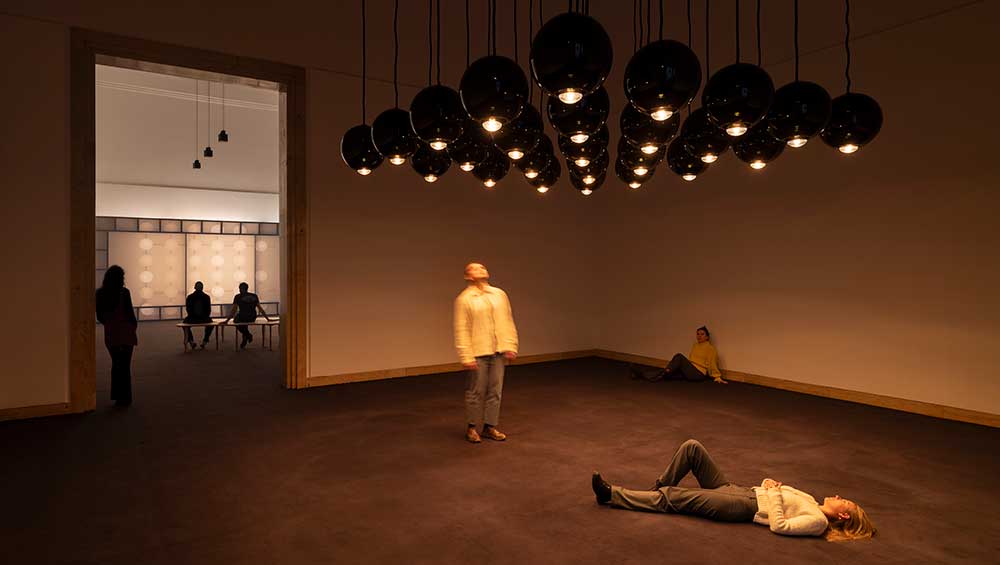
Philippe Parreno: Voices, installation view, Haus der Kunst, Munich, 13 December 2024 – 25 May 2025. Photo: Andrea Rossetti.
Haus der Kunst, Munich
13 December 2024 – 25 May 2025
by VERONICA SIMPSON
Voices is a new, immersive exhibition experience from the Paris-based artist Philippe Parreno (b1964, Algeria). And at Munich’s Haus der Kunst, the maestro of the “technological sublime” has reached new heights of menace and seduction. He has curated a series of artificial intelligence-enhanced films, moving objects, sculptures and even a “landscape” – albeit one of a very 21st-century kind – for visitors to this creepy but arrestingly glamorous neo-classical building. For those who don’t know, the Haus der Kunst was commissioned at Hitler’s request as a repository for his preferred kind of art (presumably Bavarian landscapes, buxom wenches and triumphant Aryan warriors and workers) rather than the art he labelled “degenerate” (anything abstract, conceptual, expressionist or veering from hyperreal romanticism). I wonder what he would make of its current programme, under its director, Andrea Lissoni. I don’t think he would like it – but that is intended as a massive compliment.
Maybe others less techno-sceptical than me would be captivated by this show, thrilled by the richly imagined, technically ambitious visual and sensory choreography: it’s a ballet, a passionate pas de deux between the technological and analogue, android and humanoid. It is certainly presented as a benign proposition in the introductory wall text: Voices, we’re told, turns the Haus der Kunst into a “resonating organism … generating acoustic and visual encounters where voices guide and shape the exhibition”. Sounds nice, doesn’t it?
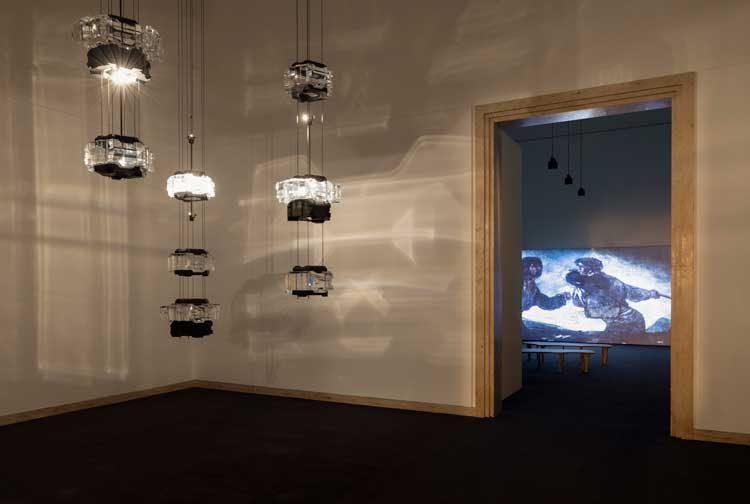
Philippe Parreno: Voices, installation view, Haus der Kunst, Munich, 13 December 2024 – 25 May 2025. Photo: Andrea Rossetti.
Ironically, I lost my voice in December, so missed the official opening of Voices, when my experience would have been mediated via the prism of PR and curatorial expertise – their “voices” guiding me towards the most positive interpretation. So, in January, I enter the gracious reception hall for the main gallery solo, and somewhat unprepared for what lies ahead (beyond reading interviews, previous show reviews and the press release). Fresh is often the best way to experience the work of artists who have made it to the highest rung of their profession; and Parreno is surely an art world megastar, hailed in August 2014 as “one of the most exciting artists of the era” in a profile in the White Review. This is the second of four mega-shows he is producing over the course of 12 months, the first being a career retrospective last year at Leeum Museum of Art in Seoul.
There are chairs scattered around the edge of the room – exquisitely crafted, curvaceous wooden chairs by the Italian artist/designer Martino Gamper, which I remember were crowded in this same room nearly 18 months ago when I came for the installations show. Now a handful of them occupy the perimeter, as if offering ballroom dancers a moment of rest. But the only dancer here is a large, slowly rotating white wall that gently pivots and directs its blisteringly bright light according to sophisticated sensors built into the frame. At first, it seems benign, amusing even, as it turns and glides towards me, its megawatt, beaming eyeball creeping closer. I stand firm, and it stops about a foot away, appearing to wait. At this distance, I can see the small round sensors embedded along its lower rim, about two feet up from the floor. These, apparently, are the same sensors that are used in cars to help you park. But at least I can walk away.
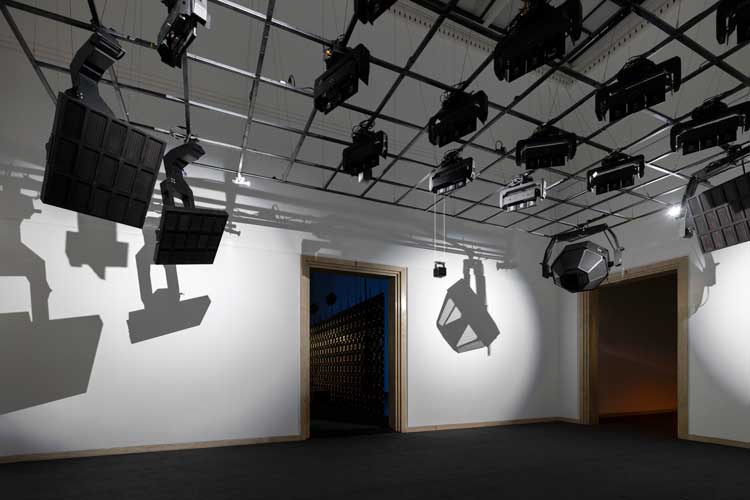
Philippe Parreno: Voices, installation view, Haus der Kunst, Munich, 13 December 2024 – 25 May 2025. Photo: Andrea Rossetti.
And I do, into the first gallery on my right, where a large screen is pulsing with softly golden, prismatic images while a calm female voice talks in a language like none I have heard before. This voice belongs to Susanne Daubner, a German TV news presenter, and the language is one that Parreno and his accomplices have concocted from data and scrambled into a new kind of language (of which, more later). The clash between its incomprehensibility and its reassuring plausibility makes for uncomfortable listening. It sounds calming and authoritative, but it is gibberish, like the fake news that assails us daily. From time to time, the kaleidoscope of imagery fades and a tall, slender structure is visible behind the projection, festooned with crystalline components – seemingly, the “author” of this voice.
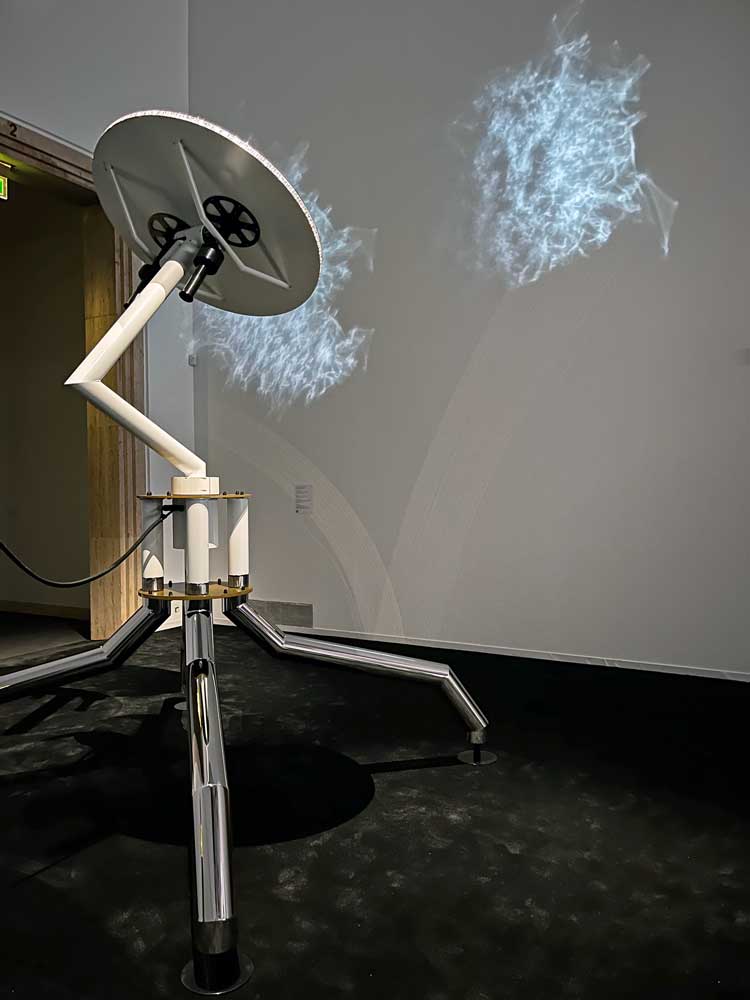
Robotic figure casting silvery webs around the main gallery. Installation view, Philippe Parreno: Voices, Haus der Kunst, Munich, 13 December 2024 – 25 May 2025. Photo: Veronica Simpson.
In the main gallery, beyond, there are more overtly “robotic” structures, or “sculptures”, as Parreno describes them in a recorded press conference interview that was sent on to me. One crouching, crab-like machine, on three gleaming steel legs, is pointing its reflective (satellite-esque) dish around the room, beaming strange, cloud-like ghosts or webs of silvery shadow. But what, we might ask, is it receiving?
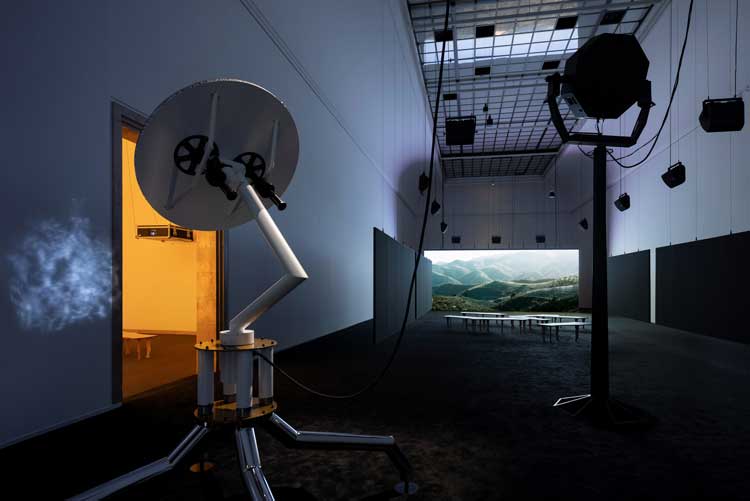
Philippe Parreno: Voices, installation view, Haus der Kunst, Munich, 13 December 2024 – 25 May 2025. Photo: Andrea Rossetti.
At the far end of this room is a large screen is showing Parreno’s film El Amendral (The Almond Grove), which is beaming images in real time from cameras placed around a piece of land in Almería, Spain. For this, I am especially glad of the press conference recording: Parreno’s explanation of this work’s inception is fascinating. First, he is playing with the classical notion of “landscape” as artifice – as representation conjured for the benefit of an aesthetic experience, first conceived as such in the 15th century. He says: “For this ‘landscape’, the land that I choose to expose us to … it’s a place which is peculiar (as) the only desert in Europe. Yet we all know it without knowing the name of it, because it … appeared in the 1960s in … spaghetti westerns. So, it’s land that’s already been transformed through the process of cinema into a ‘landscape’ thanks to Sergio Leone. So that’s part of it. It’s interesting that everybody in a way knows that place through the use of cinema. And it’s a desert, which through climate change grows into more of a desert. And people had to go away from it because it’s brutal during the summer … 50C temperatures.” He says this land was where his ancestors lived, before moving to Algeria in the 19th century, when the climate became too hostile for agriculture. (Once filled with olive trees, as the temperature rose, almond trees were tried instead and abandoned, hence the title of the film). He placed a camera there, he said: “To try and see how this landscape can now turn back and look at us. And how does this landscape see us? I had a series of sensors that send data from there, from the wind (conditions) to the slight change in atmospheric pressure, to humidity level.”
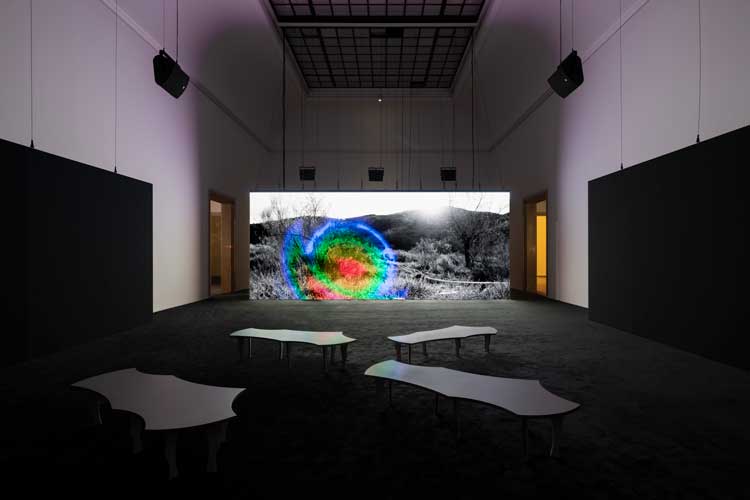
Philippe Parreno: Voices, installation view, Haus der Kunst, Munich, 13 December 2024 – 25 May 2025. Photo: Andrea Rossetti.
This data dialogue between Almería and Munich apparently plays an active part in the show (gathering, incorporating and orchestrating data for his shows is an essential Parreno trope, though the technology through which he then interprets and presents it has grown ever more sophisticated). We are receiving this information from Almería but, from what I understand, data is also being gathered from movements and interactions being monitored in and around the show and transmitted to Almería. He continues: “This antenna receives signals that we are moderating. We see the sensors are transformed into a kind of soundscape in the voice that you hear.” (Again, I think he means the live data being gathered here and in Almería is used to programme the uncanny Daubner voice and language). “So, the landscape speaks to us with some words, but also the approximate sound of a voice. It sounds like a human but not words. It sounds like the senses. I went for a voice that made sense here (in Munich), without having to make sense of what the voice says. Susanne Daubner has a voice which is known. You don’t need to hear what she says but the prosody, the musicality of the voice, you recognise. I thought it would be interesting to take this prosody from her and give it to the landscape. The landscape is addressing you through sound – sometimes words; sometimes German or English; and sometimes language that belongs to that entity which is a created language.”
You see how clever he is? This wizard is weaving verbal and technological spells around us. And that is truly the feeling as you experience this show, to an extent that makes me increasingly uneasy. Though there are some analogue elements, I don’t think they are designed to be reassuring. To the right of our landscape is a film in which Parreno observes the behaviour of underwater plants and creatures, cephalopods, in closeup and hypersharp digital focus. Although I’m told the film has not in any way been altered or Photoshopped, the images themselves seem magical, with patterns and colours exploding across the screen. Seats are provided for our comfort, to facilitate enjoyment. But periodically, the mood shifts, the projection cuts out, and lights behind the screen flicker in tandem with more of those spooky Daubner word fragments. What is reality, what is unreality? I’m inclined to think that it is the ability to evoke that liminal space in between that is Parreno’s superpower.
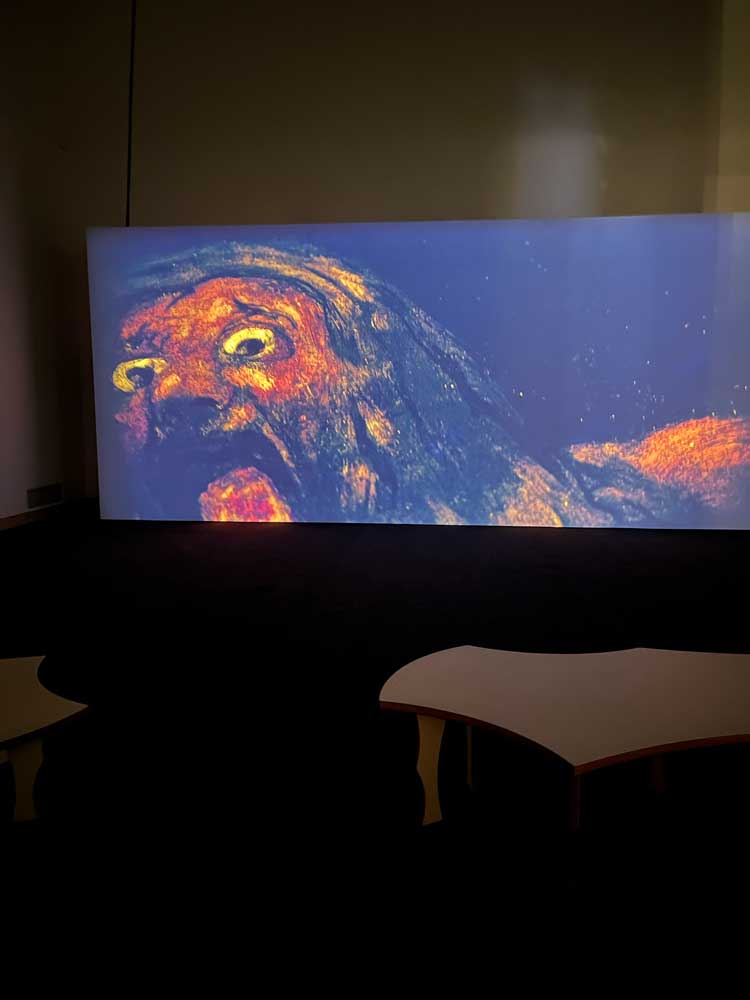
Close up of Goya's Black Paintings in Parreno's 2022 film Quinta del Sordo. Photo: Veronica Simpson.
Across the other side of the main gallery, plays another film, a much more obviously dark one. This is Quinta del Sordo, from 2022, which was previously seen that year at the Prado in Madrid. It zooms in and out using footage of Goya’s Black Paintings. Each brushstroke is rendered, in its shiny, varnished mastery, revealing gremlins, demons and haunted human faces against a sonic backdrop of rustles, groans, creaking floorboards and howling winds. Again, Parreno’s press conference precis is useful. He made this film: “a couple of years ago, during the pandemic, of the black paintings of Goya. It was a house he bought, then he had to go away for political reasons from Spain and died some time later. So, the place was destroyed, and the paintings he directly painted on the walls were removed from the wall. Now we have the series of paintings (in the Prado, Madrid), and no place for the works (to be shown) like they were … in different parts of the house, in a way that you would be haunted by when they look at you. I made the film to recreate the space that was lost, the space between the paintings. And Goya was deaf when he died, so the sound of the spaces was interesting to me to recreate.”
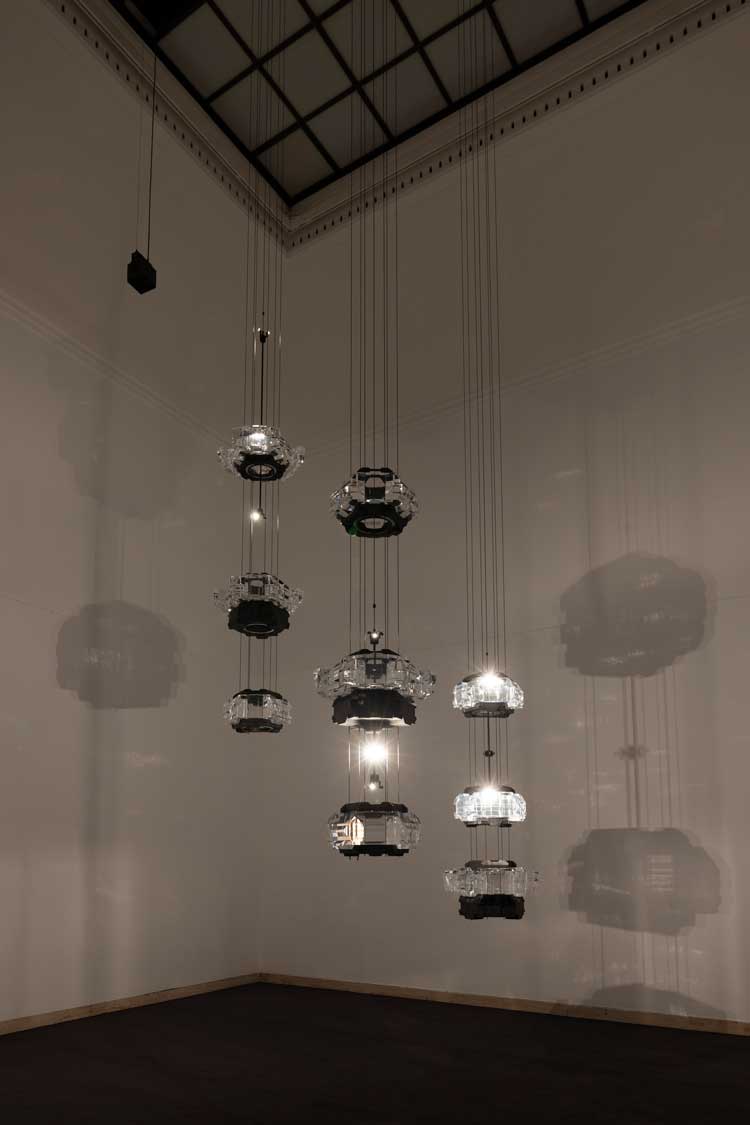
Philippe Parreno: Voices, installation view, Haus der Kunst, Munich, 13 December 2024 – 25 May 2025. Photo: Andrea Rossetti.
The rest of the show – and there are several more rooms – is mainly inhabited by Parreno’s technological “sculptures”, which in and of themselves I don’t find particularly interesting. They are more like animated light fixtures, albeit glamorous, expensive ones. The technological experience of them overrides the emotional or visual. They may be playing a part in harvesting our movements or body heat, but they are design objects, rather than artworks. In one room, a triangle of glowing heat lamps dangles from the ceiling, apparently recreating in this room the temperature currently being experienced in Almería. In an adjacent room, a collection of whirring and chattering machines is strapped up near the ceiling, emitting sounds like the clicks and lisps our mouths make between words, pivoting according to some unseen programme. This sculpture is particularly creepy.
The machine processing and programming all the technology in Munich is displayed in the corner of an end gallery. Like the technofile he is, Parreno wants you to see what is directing your experience, your interactions. By the time I reach this end gallery, I’m feeling an urgent need for fresh air and a break from this intense, machine-mediated environment. But then I encounter one of Tino Sehgal’s dancers. Sehgal and Parreno have been collaborating for 20 years. As before, at the press conference, Parreno expressed the extra, poetic dimension that Sehgal brings to his work so well that it is worth sharing here: “The reason why I ask him to do things with me is that he does things that I can’t do … He is an inventor and invented something which (reveals) how you relate to the other without an object in between people (in the context of an art gallery)? ... Without music or a stage, you share the moment of attention with another. By that you produce a form. (It’s) a really unique process of form producing … The techno apparatus that I use are tuned to reveal things we don’t perceive … and the presence of this person makes the visitor more attuned to the fact that something strange is being perceived.”
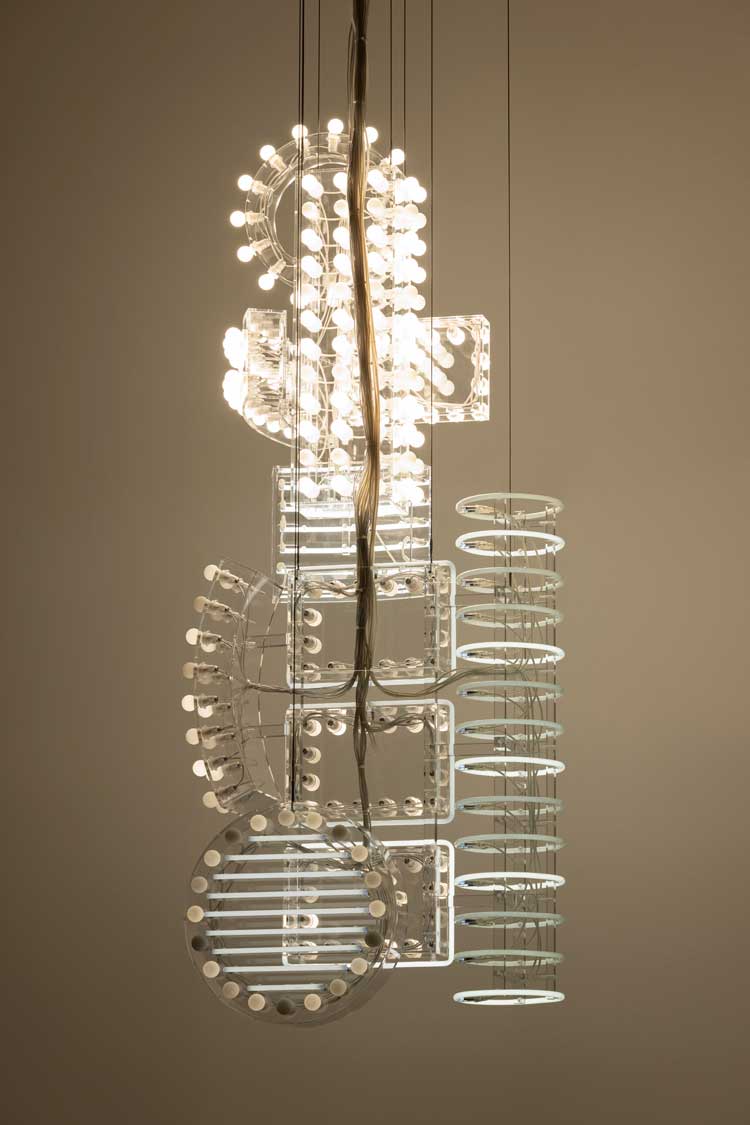
Philippe Parreno: Voices, installation view, Haus der Kunst, Munich, 13 December 2024 – 25 May 2025. Photo: Andrea Rossetti.
Lissoni tells me that Parreno insisted on “liveness as a fundamental condition of the programme. That’s why he invited Tino to conceive a component of the work, which is extremely challenging to the institution. We have six dancers on the whole time for the length of the show, from 10am to 8pm, working as an interface between robotic devices, the show, the technology and ourselves.”
In my only encounter with a dancer in the gallery, I watch a young man, with dreadlocks draped over his face, wearing baggy black clothes, walking slowly along the floor (as if experiencing wind resistance) humming quietly to himself, occasionally lifting up his head and calling out, communing with the machines that dangle above him. Whether any or all of this is intended as a celebration of the increasingly embodied experience of technology in our human lives (or our increasingly disembodied experience of life, with our heads immersed in digital “realities”), I’m not sure. But it is truly disturbing to those of us who would rather keep the machines at bay, our bodies and spirits intact. Parreno, I’ve realised, likes to summon the ghosts in these machines. And now he can make them sing.